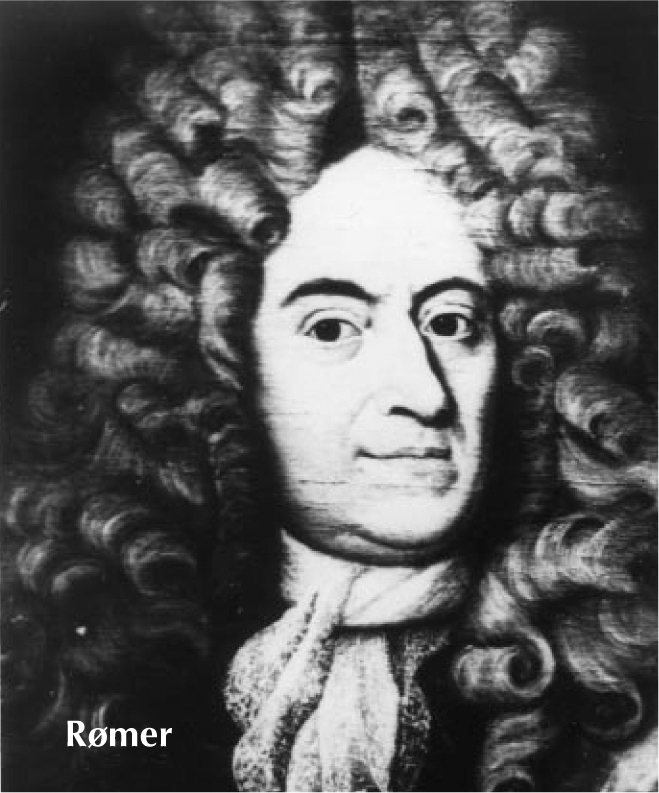Rømer and the Finite Speed of Light
DOI: 10.1063/1.1878320
Ole Rømer’s 1676 demonstration that light propagates at a finite speed must have been a revelation to the members of the French Royal Academy of Science. A young and brilliant Danish “postdoc” at the Paris Observatory, Rømer had unexpectedly answered a long-standing fundamental question. Before his discovery, the likes of René Descartes and Johannes Kepler had claimed that light was an instantaneous phenomenon, and all attempts to prove otherwise had failed.
Isaac Newton and especially Christiaan Huygens welcomed Rømer’s result; Huygens found it encouraging in the development of his wave theory of light. There were also a few ardent opponents, such as Robert Hooke and Rømer’s observatory colleague Jean Cassini.
What value of the speed of light did Rømer actually report? I found 16 references, spanning the years 1694–2003, that give values from 200 000 to 350 000 km/s. Such a range can hardly be attributed to mistakes in the conversion of measurement units.
None of the sources I found quoted an original paper or proceedings. The present French Academy of Sciences led me to proceedings of a 1976 conference marking the tricentennial of Rømer’s discovery. 1 Those proceedings include a copy of his only publication about the speed of light. 2 The sole message of that concise and tantalizing paper is that the speed of light is finite, though incredibly large. Rømer did not mention any specific value.
The first paragraph of Rømer’s paper states the question: Is light propagation an instantaneous phenomenon or does it take time? The next paragraph gives observations of Jupiter’s innermost moon (the one we now call Io) to show that light covers a distance like Earth’s diameter, “about 3000 lieues” (one lieue = 4.448 km), in less than one second. Rømer’s reasoning was as follows: If light has a finite speed, then when Earth is approaching Jupiter, Io’s period should appear shortened. Half a year later, when Earth and Jupiter move apart, the moon’s period should appear to be longer. Io’s actual period is about 42.5 hours, during which time Earth traverses “at least 210 Earth diameters.” The two periods therefore, according to Rømer, should differ by “nearly half a quarter of an hour.” But he did not observe a difference.
However, Rømer wrote, that does not mean that light travel does not take time. Comparing the time lapse of 40 successive periods of Earth’s nearing Jupiter with 40 periods while Earth is receding, he observed a perceptible difference. Therefore, he stated, light should traverse the diameter of Earth’s orbit around the Sun in 22 minutes. This retardation of light showed up in all of the observations Rømer had done at the Paris observatory since 1668.
With a good sense of dramatic timing, Rømer played his ace in the next paragraph, where he illustrated the effect of the proposed retardation of light. In early September, he had predicted that Io’s emerging from Jupiter’s shadow on 9 November would be 10 minutes late with respect to a timetable he had made up from August observations. The prediction appeared to be correct, which convinced academy members that Rømer’s idea about a finite speed of light was correct.
The final paragraph of his paper explains that none of the reasons normally used to account for irregularities in the period of a moon or planet can explain the observed deviations in the period of Jupiter’s innermost moon.
At best, the paper provides data to establish a lower limit on the speed of light. Rømer says that Earth travels in its orbit at least 210 Earth diameters in 42.5 hours. 3 If R is the radius of Earth’s circular orbit, the planet covers a distance of 2πR per year, which puts the lower limit for the radius at 9.2 × 107 km; consequently, the lower limit of the speed of light is 140 000 km/s.
Probably the first person to actually calculate the speed of light was Huygens in 1678. Rømer communicated his results to Huygens in a letter before the paper was published. In his famous Traité de la Lumière, 4 Huygens wrote that Rømer’s results had not yet been published. Huygen’s book appeared in 1690, but it had been written before 1678. In that year, he presented his theory on light at the academy.
Like Rømer, Huygens seemed barely interested in the exact value of the speed of light. He estimated Earth’s diameter to be 12 750 km and the diameter of its orbit to be 24 000 Earth diameters. According to Rømer’s observations, light traverses this distance in 22 minutes. To keep things simple, Huygens rounded the speed down to 1000 diameters per minute, or 212 400 km/s. Without the rounding, his speed of light would have been 232 000 km/s. It was Edmund Halley, in 1694, who found that Rømer’s 22 minutes should instead be 17 minutes; thus Halley gave the speed of light as approximately 300 000 km/s.
The conclusion must be that Rømer is not directly responsible for any of the values of the speed of light attributed to him. He probably was aware that the data were uncertain. But he was the first one to prove that the speed of light is finite—a scientific breakthrough that is essential to modern physics. If the speed of light were not finite, we probably would have to stick to a platinum bar in Paris for the standard meter.

AIP ESVA, E. SCOTT BARR COLLECTION

References
1. R. Taton, ed., Rømer et la Vitesse de la Lumière, Librairie Philosophique, Paris (1978).
2. O. C. Rømer, Philos. Tran., xii, 893 (1677).
3. For the possible origin of these data, see A. van Helden, J. Hist. Astr. 14, 137 (1983).
4. C. Huygens, Treatise on Light, S. P. Thompson, trans., Dover, New York (1962). Original, Traité de la Lumière, published in 1690.
More about the Authors
Fokke Tuinstra. (f.tuinstra@tnw.tudelft.nl) Delft University of Technology, Delft, Netherlands .




